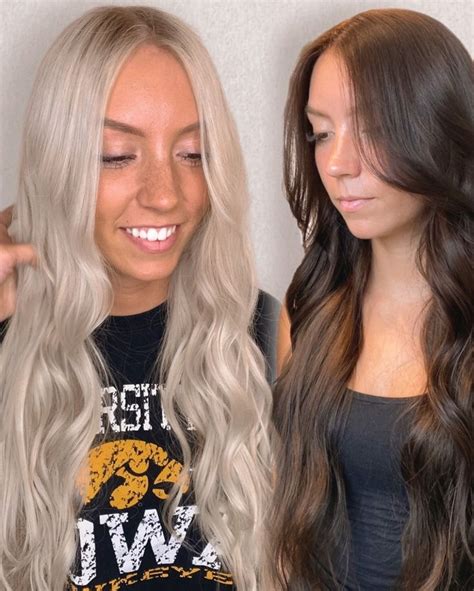Introduction
For centuries, the debate between brunettes and blondes has captivated hearts and minds, fueling countless conversations, beauty trends, and stereotypes. From the fair-haired goddesses of ancient mythology to the iconic bombshells of Hollywood, the allure and mystique of these two hair colors have permeated various societies. In this comprehensive article, we delve into the science, history, and cultural significance of brunettes and blondes, exploring the fascinating distinctions and similarities that have shaped our perception of this timeless duality.

The Biological Basis of Hair Color
The shade of our hair, whether brunette or blonde, is primarily determined by the presence and distribution of a pigment called melanin. Melanin is produced by specialized cells in the hair follicles known as melanocytes. The two main types of melanin are eumelanin, responsible for brown and black hues, and pheomelanin, responsible for red and yellow hues.
Genetics
Hair color is largely inherited, with the genes responsible for melanin production residing on chromosome 11. Several genes interact to determine the specific shade of hair, and the most influential gene is the melanocortin-1 receptor (MC1R). Variants of the MC1R gene have been linked to different hair colors, with certain alleles promoting the production of eumelanin, leading to darker hair, while other alleles promote pheomelanin production, resulting in lighter hair.
Hormones
Hormones also play a role in hair color. The hormone estrogen, produced in higher levels in women than in men, stimulates the production of melanin, which can lead to darker hair in females. Conversely, the hormone testosterone, produced in higher levels in men, can inhibit melanin production, contributing to lighter hair color.
Age
Melanin production naturally decreases with age. As a result, hair tends to lighten over time. This process is particularly noticeable in individuals who start with darker hair colors.
Cultural Perceptions
The cultural significance of hair color has varied greatly throughout history and across different cultures. In some societies, brunettes have been associated with intelligence, sophistication, and strength, while blondes have been associated with youthfulness, beauty, and allure. In the Western world, the image of the “blonde bombshell” has been popularized in popular culture, creating a strong association between blonde hair and glamour and desirability.
Historical Context
Throughout history, the perception of brunettes and blondes has been influenced by social and cultural factors. In ancient Greece, blonde hair was considered a sign of beauty and divinity, while in medieval Europe, blonde women were often associated with witchcraft and paganism. The Renaissance saw a shift towards valuing darker hair colors, particularly among the upper classes. In the 19th century, lighter hair colors became fashionable again, influenced by the Romantics’ fascination with nature and youthfulness.
Modern Perceptions
Today, the cultural perceptions of brunettes and blondes continue to evolve. While stereotypes and preferences may vary depending on the context and individual tastes, both hair colors are generally viewed as attractive and desirable. However, certain associations persist, such as the notion that brunettes are more serious and intelligent, while blondes are more sociable and outgoing.
The Science of Hair Coloration
Whether you were born with brunette or blonde hair, you may have considered changing your hair color at some point. The science of hair coloration involves altering the melanin content of the hair. There are two main types of hair coloration:
Temporary
Temporary hair coloration, such as shampoos, conditioners, and rinses, coats the hair with pigments that wash out after a few washes. This type of coloration is ideal for changing your hair color without a long-term commitment or damage to your hair.
Permanent
Permanent hair coloration, such as hair dyes, alters the melanin content of the hair permanently. This is achieved by using chemicals that break down the existing melanin molecules and replace them with new pigments. Permanent hair coloration can be used to cover gray hair, darken hair, or lighten hair.
Choosing Between Brunette and Blonde
If you’re considering changing your hair color, there are several factors to consider when choosing between brunette and blonde:
Skin Tone
Brunette hair colors generally complement warm skin tones, such as olive or honey-colored skin, while blonde hair colors generally complement cool skin tones, such as pink or porcelain-colored skin. However, there are exceptions to this rule, and the best way to determine which hair color suits you is to consult with a professional hair stylist.
Eye Color
Brunette hair colors can enhance the depth of brown, hazel, and green eyes, while blonde hair colors can make blue and gray eyes appear brighter. Again, personal preferences and individual features should be taken into account when making a decision.
Personal Style
Ultimately, the best hair color for you is the one that makes you feel confident and beautiful. Whether you prefer the sophistication of brunette or the brightness of blonde, choose a hair color that reflects your personality and style.
Useful Tables
Table 1: Prevalence of Hair Colors by Region
| Region | Brunette (%) | Blonde (%) |
|---|---|---|
| Africa | 85-95 | 2-5 |
| Asia | 75-90 | 5-15 |
| Europe | 50-75 | 20-35 |
| North America | 50-60 | 30-40 |
| South America | 60-70 | 25-35 |
Table 2: Traits Associated with Brunettes and Blondes
| Trait | Brunettes | Blondes |
|---|---|---|
| Intelligence | Perceived as more intelligent | Perceived as less intelligent |
| Beauty | Perceived as equally beautiful | Perceived as more beautiful |
| Allure | Perceived as less alluring | Perceived as more alluring |
| Seriousness | Perceived as more serious | Perceived as less serious |
| Outgoingness | Perceived as less outgoing | Perceived as more outgoing |
Table 3: Hair Color Preferences by Gender
| Gender | Brunette | Blonde |
|---|---|---|
| Men | 40% | 60% |
| Women | 60% | 40% |
Table 4: Famous Brunettes and Blondes
| Brunette | Blonde |
|---|---|
| Audrey Hepburn | Marilyn Monroe |
| Elizabeth Taylor | Grace Kelly |
| Jennifer Lopez | Elle Macpherson |
| Kate Middleton | Charlize Theron |
| Michelle Obama | Beyoncé |
Conclusion
The debate between brunettes and blondes is a timeless one, with each hair color holding its unique charm and allure. Whether you prefer the richness of brunette or the radiance of blonde, understand that beauty lies in embracing your unique features, regardless of your hair color. As you navigate the world of hair color choices, remember that the most important factor is finding a color that makes you feel confident and beautiful.
